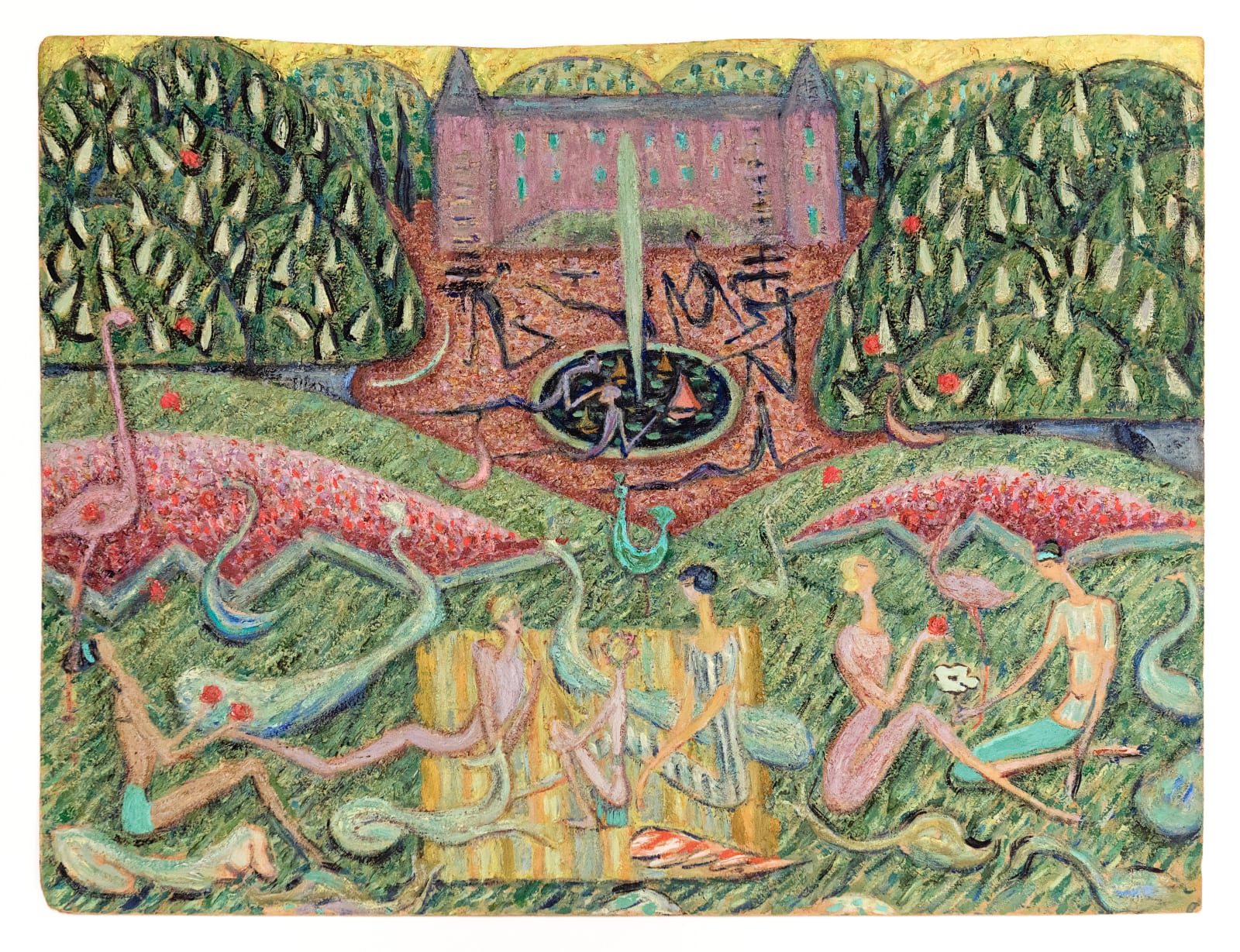
JULIETTE ROCHE Française , 1884-1980
Oil on cardboard
15 7/8 x 21 1/4 in
Cette œuvre a été réalisée en 1918 lors du séjour du couple Roche-Gleizes à New York.
On découvre plusieurs groupes de personnages entourés de paons, de flamants roses, de cygnes et d’autres petits oiseaux. Le paysage est sectionné en plusieurs plans. Le premier plan est délimité par l’herbe, sur cette pelouse, on retrouve six femmes dans diverses attitudes qui semblent pique-niquer au milieu d’oiseaux divers. Le groupe des trois femmes au centre semble être une citation directe au Déjeuner sur l’Herbe d’Édouard Manet, le groupe étant inversé, exclusivement féminin et une seule femme est habillée, à la différence de celui du maître impressionniste.
Les trois autres femmes de ce premier plan sont réparties de part et d’autre de ce groupe. Deux d’entre elles jonglent et la dernière regarde celle de droite.
Le deuxième plan reprend ces figures noires nues dansantes qu’elle à représenter plusieurs fois pendant cette période américaine. Ces figures mouvantes sont sur un sol de terre battue autour d’une fontaine dans laquelle des bateaux voguent. Le bâtiment derrière ces figures pourrait être le bâtiment de l’Arsenal de Central Park construit en 1847 avant même le parc. Devant cet Arsenal, il y avait depuis les années 1860 la ménagerie de Central Park. Tous ces oiseaux et animaux pourraient y faire écho. Dans cette œuvre, Juliette Roche peint un éden, un jardin primordial aux couleurs vives et chaudes où les plaisirs et le jeu occupent une place principale. Cette représentation de jardin n’est pas sans rappeler son amour pour ces derniers qu’elle a beaucoup représenté au début des années 1910 à Paris.
Cette œuvre est un écho à son American Picnic conservé au Musée National d’Art Moderne - Centre Pompidou, on y retrouve beaucoup des thèmes qu’elle a exploré dans cette toile entre les figures dansante rappelant celle de Matisse dans sa Danse de 1910 conservé au musée de l’Ermitage ou encore à sa très célèbre toile le Bonheur de vivre datée des années 1905–1906 conservée à la Barnes Foundation. En effet dans le Bonheur de Vivre, Matisse représente son Éden avec ce premier plan aux figures lascives et ce second plan de ronde dansante à laquelle Juliette Roche fait directement écho dans sa composition.
__
Born in 1884 and died in 1980, Juliette Roche embodies the women artist of the early 20th century. Her career covered the years 1906 to 1950. Her rich and varied work is marked by important events such as her encounter with the Cubist group in 1913, which led to her marriage with Albert Gleizes in 1915. That same year, the couple moved to New York, where Roche was introduced to the Arensberg circle by Marcel Duchamp. It was during this American period that she took part in the activities of the Dada group and became close to Francis Picabia. Her return to France in the 1920s was marked by the enrichment of her work with various publications.
This work was produced in 1918 during the Roche-Gleizes couple's stay in New York.
It shows several groups of figures surrounded by peacocks, pink flamingos, swans and other small birds. The landscape is divided into several planes. The foreground is delineated by the grass, on which six women in various poses appear to be picnicking amidst a variety of birds. The group of three women in the centre seems to be a direct quote from Édouard Manet's Déjeuner sur l'Herbe, the group being inverted, exclusively female, and only one woman is dressed, unlike the one by the Impressionist master.
The other three women in the foreground are on either side of the group. Two of them are juggling and the last one is looking at the one on the right.
The second plane features the dancing nude black figures that she portrayed several times during her American period. These moving figures are on a dirt floor around a fountain in which boats are sailing. The building behind these figures could be the Arsenal building in Central Park, built in 1847 before the park itself. In front of this Arsenal, since the 1860s, there has been the Central Park menagerie. All these birds and animals could be echoes of it. In this work, Juliette Roche paints an Eden, a primordial garden in bright, warm colours, where pleasure and play are the main themes. This depiction of a garden is reminiscent of her love of gardens, which she painted extensively in Paris in the early 1910s.
This work echoes her American Picnic, kept at the Musée National d'Art Moderne - Centre Pompidou, where we find many of the themes she explored in this painting, from the dancing figures reminiscent of those in Matisse's 1910 Dance, kept at the Hermitage Museum, to her very famous painting Bonheur de vivre, dated 1905-1906 and kept at the Barnes Foundation.
In Le Bonheur de Vivre, Matisse depicts his Eden with a foreground of lascivious figures and a background of dancing dancers, directly echoed in Juliette Roche's composition.